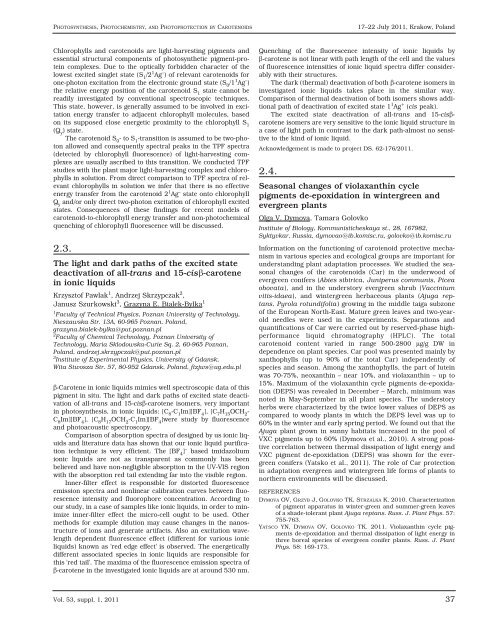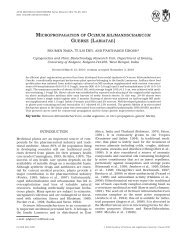ACTA BIOLOGICA CRACOVIENSIA
ACTA BIOLOGICA CRACOVIENSIA
ACTA BIOLOGICA CRACOVIENSIA
Create successful ePaper yourself
Turn your PDF publications into a flip-book with our unique Google optimized e-Paper software.
PHOTOSYNTHESIS, PHOTOCHEMISTRY, AND PHOTOPROTECTION BY CAROTENOIDS<br />
Chlorophylls and carotenoids are light-harvesting pigments and<br />
essential structural components of photosynthetic pigment-protein<br />
complexes. Due to the optically forbidden character of the<br />
lowest excited singlet state (S 1 /2 1 Ag – ) of relevant carotenoids for<br />
one-photon excitation from the electronic ground state (S 0 /1 1 Ag – )<br />
the relative energy position of the carotenoid S 1 state cannot be<br />
readily investigated by conventional spectroscopic techniques.<br />
This state, however, is generally assumed to be involved in excitation<br />
energy transfer to adjacent chlorophyll molecules, based<br />
on its supposed close energetic proximity to the chlorophyll S 1<br />
(Q y ) state.<br />
The carotenoid S 0 - to S 1 -transition is assumed to be two-photon<br />
allowed and consequently spectral peaks in the TPF spectra<br />
(detected by chlorophyll fluorescence) of light-harvesting complexes<br />
are usually ascribed to this transition. We conducted TPF<br />
studies with the plant major light-harvesting complex and chlorophylls<br />
in solution. From direct comparison to TPF spectra of relevant<br />
chlorophylls in solution we infer that there is no effective<br />
energy transfer from the carotenoid 2 1 Ag – state onto chlorophyll<br />
Q y and/or only direct two-photon excitation of chlorophyll excited<br />
states. Consequences of these findings for recent models of<br />
carotenoid-to-chlorophyll energy transfer and non-photochemical<br />
quenching of chlorophyll fluorescence will be discussed.<br />
2.3.<br />
The light and dark paths of the excited state<br />
deactivation of all-trans and 15-cisβ-carotene<br />
in ionic liquids<br />
Krzysztof Pawlak 1 , Andrzej Skrzypczak 2 ,<br />
Janusz Szurkowski 3 , Grazyna E. Bialek-Bylka 1<br />
1Faculty of Technical Physics, Poznan University of Technology,<br />
Nieszawska Str. 13A, 60-965 Poznan, Poland,<br />
grazyna.bialek-bylka@put.poznan.pl<br />
2Faculty of Chemical Technology, Poznan University of<br />
Technology, Maria Sklodowska-Curie Sq. 2, 60-965 Poznan,<br />
Poland, andrzej.skrzypczak@put.poznan.pl<br />
3Institute of Experimental Physics, University of Gdansk,<br />
Wita Stwosza Str. 57, 80-952 Gdansk, Poland, fizjws@ug.edu.pl<br />
β-Carotene in ionic liquids mimics well spectroscopic data of this<br />
pigment in situ. The light and dark paths of excited state deactivation<br />
of all-trans and 15-cisβ-carotene isomers, very important<br />
in photosynthesis, in ionic liquids: [C 8 -C 1 Im][BF 4 ], [C 7 H 15 OCH 2 -<br />
C 8 Im][BF 4 ], [C 8 H 17 OCH 2 -C 1 Im][BF 4 ]were study by fluorescence<br />
and photoacoustic spectroscopy.<br />
Comparison of absorption spectra of designed by us ionic liquids<br />
and literature data has shown that our ionic liquid purification<br />
technique is very efficient. The [BF 4 ] – based imidazolium<br />
ionic liquids are not as transparent as commonly has been<br />
believed and have non-negligible absorption in the UV-VIS region<br />
with the absorption red tail extending far into the visible region.<br />
Inner-filter effect is responsible for distorted fluorescence<br />
emission spectra and nonlinear calibration curves between fluorescence<br />
intensity and fluorophore concentration. According to<br />
our study, in a case of samples like ionic liquids, in order to minimize<br />
inner-filter effect the micro-cell ought to be used. Other<br />
methods for example dilution may cause changes in the nanostructure<br />
of ions and generate artifacts. Also an excitation wavelength<br />
dependent fluorescence effect (different for various ionic<br />
liquids) known as 'red edge effect' is observed. The energetically<br />
different associated species in ionic liquids are responsible for<br />
this 'red tail'. The maxima of the fluorescence emission spectra of<br />
β-carotene in the investigated ionic liquids are at around 530 nm.<br />
Vol. 53, suppl. 1, 2011<br />
17–22 July 2011, Krakow, Poland<br />
Quenching of the fluorescence intensity of ionic liquids by<br />
β-carotene is not linear with path length of the cell and the values<br />
of fluorescence intensities of ionic liquid spectra differ considerably<br />
with their structures.<br />
The dark (thermal) deactivation of both β-carotene isomers in<br />
investigated ionic liquids takes place in the similar way.<br />
Comparison of thermal deactivation of both isomers shows additional<br />
path of deactivation of excited state 1 1Ag + (cis peak).<br />
The excited state deactivation of all-trans and 15-cisβcarotene<br />
isomers are very sensitive to the ionic liquid structure in<br />
a case of light path in contrast to the dark path-almost no sensitive<br />
to the kind of ionic liquid.<br />
Acknowledgement is made to project DS. 62-176/2011.<br />
2.4.<br />
Seasonal changes of violaxanthin cycle<br />
pigments de-epoxidation in wintergreen and<br />
evergreen plants<br />
Olga V. Dymova, Tamara Golovko<br />
Institute of Biology, Kommunisticheskaya st., 28, 167982,<br />
Syktyvkar, Russia, dymovao@ib.komisc.ru, golovko@ib.komisc.ru<br />
Information on the functioning of carotenoid protective mechanism<br />
in various species and ecological groups are important for<br />
understanding plant adaptation processes. We studied the seasonal<br />
changes of the carotenoids (Car) in the underwood of<br />
evergreen conifers (Abies sibirica, Juniperus communis, Picea<br />
obovata), and in the understory evergreen shrub (Vaccinium<br />
vitis-idaea), and wintergreen herbaceous plants (Ajuga reptans,<br />
Pyrola rotundifolia) growing in the middle taiga subzone<br />
of the European North-East. Mature green leaves and two-yearold<br />
needles were used in the experiments. Separations and<br />
quantifications of Car were carried out by reserved-phase highperformance<br />
liquid chromatography (HPLC). The total<br />
carotenoid content varied in range 500-2800 μg/g DW in<br />
dependence on plant species. Car pool was presented mainly by<br />
xanthophylls (up to 90% of the total Car) independently of<br />
species and season. Among the xanthophylls, the part of lutein<br />
was 70-75%, neoxanthin – near 10%, and violaxanthin – up to<br />
15%. Maximum of the violaxanthin cycle pigments de-epoxidation<br />
(DEPS) was revealed in December – March, minimum was<br />
noted in May-September in all plant species. The understory<br />
herbs were characterized by the twice lower values of DEPS as<br />
compared to woody plants in which the DEPS level was up to<br />
60% in the winter and early spring period. We found out that the<br />
Ajuga plant grown in sunny habitats increased in the pool of<br />
VXC pigments up to 60% (Dymova et al., 2010). A strong positive<br />
correlation between thermal dissipation of light energy and<br />
VXC pigment de-epoxidation (DEPS) was shown for the evergreen<br />
conifers (Yatsko et al., 2011). The role of Car protection<br />
in adaptation evergreen and wintergreen life forms of plants to<br />
northern environments will be discussed.<br />
REFERENCES<br />
DYMOVA OV, GRZYB J, GOLOVKO TK, STRZALKA K. 2010. Characterization<br />
of pigment apparatus in winter-green and summer-green leaves<br />
of a shade-tolerant plant Ajuga reptans. Russ. J. Plant Phys. 57:<br />
755-763.<br />
YATSCO YN, DYMOVA OV, GOLOVKO TK. 2011. Violaxanthin cycle pigments<br />
de-epoxidation and thermal dissipation of light energy in<br />
three boreal species of evergreen conifer plants. Russ. J. Plant<br />
Phys. 58: 169-173.<br />
37












